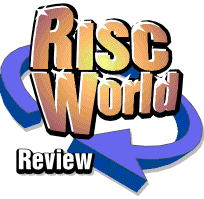



Digital Photography World
Paul Johnson opens the new RISC World column dedicated to cameras and things you can do to photographs using your computer.
Digital cameras have come a long way in the past number of years. We've had the dedicated link ones (such as the CasioQV10), the truly independent ones (Sony Mavica) to the flash memory cameras (Minolta Dimage). They connect to a variety of machines, through a plethora of interfaces; the most recent (and fast growing to be the most popular) being USB.
I first came across digital photography at work (University of Salford). I was part of a project team and we needed some high quality pictures which could be transmitted over the web. There was a simple choice, decent SLR and scanner, or a digital camera. While the SLR was a nice idea, it would have been quite complex and the pictures deteriorate over time (plus scanners at the time were quite naff). In the end, a Sony Mavica MV7 was bought. Main reason, everything was stored on floppy.
Why was this so important?
Digital cameras are firmly split into two camps: normal memory and disc memory. Both have exactly the same benefits and drawbacks (fewer images at higher resolutions, inability to review and delete pictures) but normal memory versions have to download to a machine.
If the person does not have a machine capable of accessing the camera interface (either does not have, say, USB or suitable software), then that camera is pretty useless; you will only be able to view the pictures on the camera with a typical viewing screen of about 25mm x 25mm. Picture frame speed (the speed at which a picture is taken) though is fast. Compact flash cameras fall into this bracket.
Disc based cameras have as much memory as you have floppy disc space. You need no special software (well, ChangeFSI for the original Mavica as it had an odd header), just a machine capable of displaying JPEGs and using PC discs. With a bit of fiddling, this is possible on even a RISC OS 2 machine! They do have the disadvantage of having a slow frame speed. With the price of floppies, and the high quality graphics software on Mac and RISC OS (we were a diverse group!), a disc based camera was an obvious choice.
Acorn was a nice company when it came to digital cameras. They had seen how important they would become and started supporting them. One such camera supported was the cheap and cheerful Casio QV10. This camera is capable for taking two resolutions of picture - high and low. All pictures are stored internally and are viewable on the camera. The QV10 has a self timer and a few other fun features. It is non-expandable and does not have an internal flash. Connection is via the serial port on any RISC OS machine. It does have one problem - pictures can turn out a decidedly blue colour.
PhotoQV was Acorn's driver software for the Casio QV10. This was very easy to use - you plug the camera into the serial port, make sure everything is switched on and click on the iconbar icon. The program downloads the data from the camera (without erasing it - the software cannot do this) and produces a "slide viewer". This slide show can then be saved as a (potentially) large file containing all of the pictures as a stream. The problem with this is that you can only use the !PhotoQV application then to view the pictures, which can be a bit of a pain - especially if the software corrupts the image on its way down the serial cable.
The "slide viewer" from the QV10 camera
The application though is powerful enough to control of the camera remotely. You can take pictures individually or as a time-lapse. Very useful indeed.
To enlarge a picture simply click on the slide you want to see. You are then presented with another window which allows for modifying the orientation and image dithering. The orientation range is quite good. The picture display reflects the orientation selected. The colour details is also displayed. Clicking on OK will give you the full picture which can then be saved as a JPEG, Acorn sprite or as a CAM file (the webcam file format which Acorn had been working on, but didn't really develop much) The QV10 is really a kids digital camera - if you can pick one up second hand, it'll do for absolute beginners (it's the 110 or 126 of digital cameras). Watch out though - these cameras had a really terrible battery door lock.
Modifying an image orientation
Next time
For the next issue, we'll go further into the realms of digital photography, with a look at essential support software; more on the Mavica and with luck details of how USB will affect access to cameras for RISC OS users.
I must thank Bev (my wife) for letting me use these pictures of Richard (my son), without whom, you'd be looking at some very brightly coloured pictures of a thermite reaction taken at the 2001 Open University Chemistry Summer School practical day.
Paul Johnson